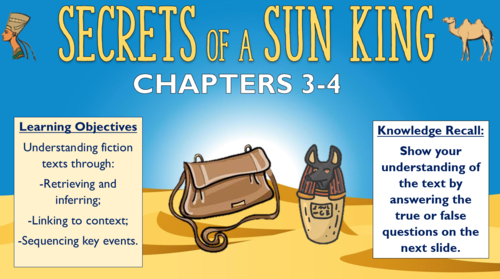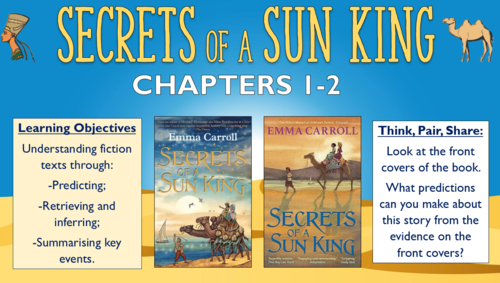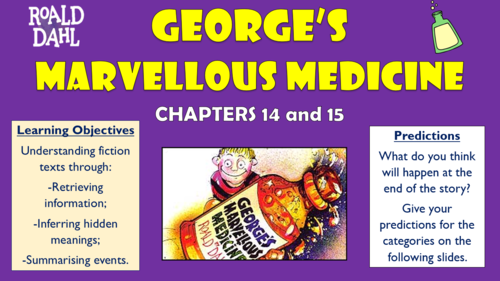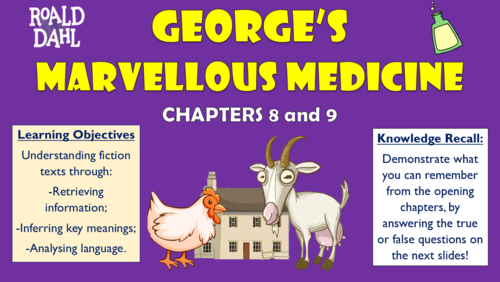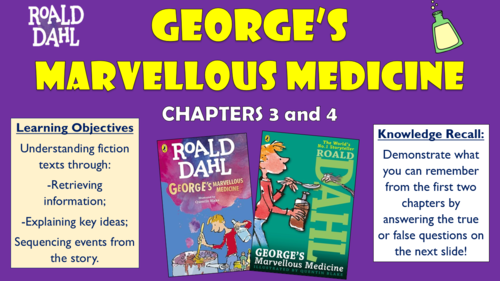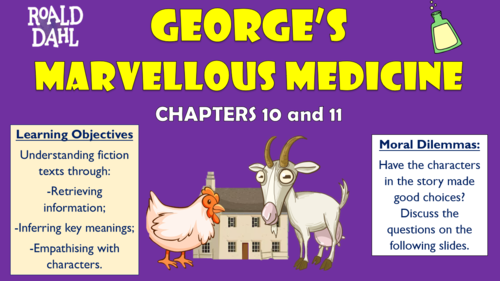
3k+Uploads
2014k+Views
2322k+Downloads
English

Secrets of a Sun King - Chapters 3 and 4 - Double Lesson!
This engaging and thought-provoking double-lesson resource aids students in developing a secure understanding of the chapters 3 to 4 of Emma Carroll’s 'Secrets of a Sun King.’ In this section of the text, Lil meets Tulip and Oz for the first time, and visits her Grandad in the hospital, where she learns of the curse.
The comprehensive and colourful PowerPoint presentation enables students to understand the text through:
-Retrieving information;
-Inferring and deducing hidden meanings;
-Linking ideas from the text to context;
-Sequencing the key events of the chapters.
The sessions include a range of retrieval, vocabulary, inference, explanation and deeper thinking activities. A clear, colourful and comprehensive PowerPoint presentation guides students through the learning.
There’s a lot in the session (20 slides in total) so I would recommend breaking into two lessons. The lessons are most suitable for children in key stage 2, (they were originally used for those in years 4 and 5).

Secrets of a Sun King - Chapters 1 and 2 - Double Lesson!
This engaging and thought-provoking double-lesson resource aids students in developing a secure understanding of the chapters 1 to 2 of Emma Carroll’s 'Secrets of a Sun King.’ In this section of the text, Lil’s grandfather is taken to hospital, and she is both mystified and captivated after opening the package containing the ancient Egyptian jar.
The comprehensive and colourful PowerPoint presentation enables students to understand the text through:
-Making predictions;
-Retrieving information;
-Inferring and deducing hidden meanings;
-Summarising the key events of the chapters.
The sessions include a range of retrieval, vocabulary, inference, explanation and deeper thinking activities. A clear, colourful and comprehensive PowerPoint presentation guides students through the learning.
There’s a lot in the session (20 slides in total) so I would recommend breaking into two lessons. The lessons are most suitable for children in key stage 2, (they were originally used for those in years 4 and 5).

George's Marvellous Medicine - Chapters 12 and 13 - Double Lesson!
This engaging and thought-provoking double-lesson resource aids students in developing a secure understanding of chapters 12 and 13 of Roald Dahl’s ‘George’s Marvellous Medicine.’ The chapters covered in these lessons are ‘Marvellous Medicine Number Two’ and ‘Marvellous Medicine Number 3.’
The lessons are guided by a comprehensive and colourful PowerPoint presentation, and enables students to understand the text through:
-Retrieving information;
-Inferring hidden meanings;
-Making predictions.
The sessions include a range of retrieval, vocabulary, inference, explanation and deeper thinking activities. A clear, colourful and comprehensive PowerPoint presentation guides students through the learning.
There’s a lot in the session (17 slides in total) so I would recommend breaking into two lessons. The lessons are most suitable for children in upper key stage 1 or lower key stage 2, (they have been used in the past with children in years 2 and 3) but they could also be adapted for slightly older and younger year groups.

George's Marvellous Medicine - Chapters 14 and 15 - Double Lesson!
This engaging and thought-provoking double-lesson resource aids students in developing a secure understanding of chapters 14 and 15 of Roald Dahl’s ‘George’s Marvellous Medicine.’ The chapters covered in these lessons are ‘Marvellous Medicine Number Four’ and ‘Goodbye Grandma.’
The lessons are guided by a comprehensive and colourful PowerPoint presentation, and enables students to understand the text through:
-Retrieving information;
-Inferring hidden meanings;
-Summarising events.
The sessions include a range of retrieval, vocabulary, inference, explanation and deeper thinking activities. A clear, colourful and comprehensive PowerPoint presentation guides students through the learning. A storyboard template is also provided for the creative activity (in both Word and PDF).
There’s a lot in the session (18 slides in total) so I would recommend breaking into two lessons. The lessons are most suitable for children in upper key stage 1 or lower key stage 2, (they have been used in the past with children in years 2 and 3) but they could also be adapted for slightly older and younger year groups.

George's Marvellous Medicine - Chapters 8 and 9 - Double Lesson!
This engaging and thought-provoking double-lesson resource aids students in developing a secure understanding of chapters 8 and 9 of Roald Dahl’s ‘George’s Marvellous Medicine.’ The chapters covered in these lessons are ‘The Brown Hen’ and ‘'The Pig, the Bullocks, the Sheep, the Pony and the Nanny-goat.’
The lessons are guided by a comprehensive and colourful PowerPoint presentation, and enables students to understand the text through:
-Retrieving information;
-Inferring hidden meanings;
-Analysing language.
The sessions include a range of retrieval, vocabulary, inference, explanation and deeper thinking activities. A clear, colourful and comprehensive PowerPoint presentation guides students through the learning.
There’s a lot in the session (19 slides in total) so I would recommend breaking into two lessons. The lessons are most suitable for children in upper key stage 1 or lower key stage 2, (they have been used in the past with children in years 2 and 3) but they could also be adapted for slightly older and younger year groups.

George's Marvellous Medicine - Chapters 3 and 4 - Double Lesson!
This engaging and thought-provoking double-lesson resource aids students in developing a secure understanding of the chapters 3 to 4 of Roald Dahl’s ‘George’s Marvellous Medicine.’ The chapters covered in these lessons are ‘George Begins to Make the Medicine’ and ‘Animal Pills.’
The lessons are guided by a comprehensive and colourful PowerPoint presentation, and enables students to understand the text through:
-Retrieving information;
-Explaining key meanings;
-Sequencing events.
The sessions include a range of retrieval, vocabulary, inference, explanation and deeper thinking activities. A clear, colourful and comprehensive PowerPoint presentation guides students through the learning.
There’s a lot in the session (18 slides in total) so I would recommend breaking into two lessons. The lessons are most suitable for children in upper key stage 1 or lower key stage 2, (they have been used in the past with children in years 2 and 3) but they could also be adapted for slightly older and younger year groups.

George's Marvellous Medicine - Chapters 10 and 11 - Double Lesson!
This engaging and thought-provoking double-lesson resource aids students in developing a secure understanding of chapters 10 and 11 of Roald Dahl’s ‘George’s Marvellous Medicine.’ The chapters covered in these lessons are ‘A Crane for Grandma’ and 'Mr Kranky’s Great Idea.’
The lessons are guided by a comprehensive and colourful PowerPoint presentation, and enables students to understand the text through:
-Retrieving information;
-Inferring hidden meanings;
-Empathising with characters.
The sessions include a range of retrieval, vocabulary, inference, explanation and deeper thinking activities. A clear, colourful and comprehensive PowerPoint presentation guides students through the learning.
There’s a lot in the session (19 slides in total) so I would recommend breaking into two lessons. The lessons are most suitable for children in upper key stage 1 or lower key stage 2, (they have been used in the past with children in years 2 and 3) but they could also be adapted for slightly older and younger year groups.

George's Marvellous Medicine - Chapters 1 and 2 - Double Lesson!
This engaging and thought-provoking double-lesson resource aids students in developing a secure understanding of the chapters 1 to 2 of Roald Dahl’s 'George’s Marvellous Medicine.’ The chapters covered in these lessons are ‘Grandma’ and ‘The Marvellous Plan.’
The lessons are guided by a comprehensive and colourful PowerPoint presentation, and enables students to understand the text through:
-Making predictions;
-Retrieving information;
-Inferring and deducing hidden meanings.
The sessions include a range of retrieval, vocabulary, inference, explanation and deeper thinking activities. A clear, colourful and comprehensive PowerPoint presentation guides students through the learning. A worksheet/ template is also provided for the creative medicine activity (in both Word and PDF format).
There’s a lot in the session (20 slides in total) so I would recommend breaking into two lessons. The lessons are most suitable for children in upper key stage 1 or lower key stage 2, (they have been used in the past with children in years 2 and 3) but they could also be adapted for slightly older and younger year groups.

Lord of the Flies Pointless Game! (and blank template to make your own games!)
Based on the popular game show ‘Pointless’, this resource is perfect for use as a whole lesson resource, enrichment option, or revision tool. Editable, so that you can change to any other topic or change questions. (I’ve also added a blank template so that you can make your own games from scratch). Containing almost 30 slides of sound clips, engaging visuals, and suitably challenging questions, this resource is effective at both promoting engagement and enhancing learning. There are several full rounds of questions to build or revisit knowledge of characters, plot, and themes in ‘Lord of the Flies:’
Round 1. The characters in Lord of the Flies (takes approx 10 mins)
Round 2. Quotations from the text (takes approx 15 mins)
3. Settings, themes, and objects (takes approx 15 mins)
4. Themes in Lord of the Flies (takes approx 10 mins)
The nature of this game ensures that the resource can challenge students of all levels.

Space Mission: Find us a New Earth!
The year is 2086, and the students are needed for a special mission!
This space mission has been designed to provide students with a fun and interesting group challenge, whilst also building key skills in critical thinking and collaboration, and essential knowledge for Science, English, and Mathematics.
Students are placed in a scenario in which Earth is no longer habitable, and humans must seek to move to another planet in the Universe. Compiled for them is information on each of the potentially most habitable planets that are known to man (these are the real planets that have been confirmed by NASA and other agencies as having the most potential for life). In reading the key information, students will be drawing upon their knowledge of Science terminology, and will need to make some Maths calculations to work out implications of living on different planets.
What will become clear fairly quickly is that none of the potential planets are perfect, and they must use reasoned judgements to determine which of them have cons that could perhaps be overcome. They then present their ideas, using clear and articulate speaking and listening skills, and write up their report, using appropriate written communication (a scaffold is provided to frame this).
Everything is provided for you to download, print, and teach:
- A comprehensive, whole-activity PowerPoint that guides the students through the mission;
- Detailed and colourful information sheets on each of the contender planets for being the next Earth (these include links to amazing websites that can provide the children with more information);
- A ‘Pros and Cons’ scaffold, to help students record their findings;
- An information sheet on the ‘habitable zone’ around stars;
- A scaffold for writing up findings;
- Sorting cards for help with determining the key features of habitable planets;
- Full teacher guidance.
Considering the time and effort that it took to create these resources, I think that they offer exceptional value. Whenever I have used this activity before, it has taken at least 2-3 lessons, including the introduction, starter challenge, main mission, presentations, and write-up. I originally have used this with mid-ability Year 6,7, and 8 groups, but colleagues have easily adapted it for students across key stages 2-4.
All images have been cited at the end of the PowerPoint presentation and are licensed for commercial use.

Tree: Seasons Come, Seasons Go - Whole Class Reading Session!
This whole class reading session aims to develop children’s fluency and comprehension skills through reading Britta Teekuntrup’s ‘Tree: Seasons Come, Seasons Go.’
The reading is followed by a series of activities aiming to develop children’s retrieval, explanation, inference, prediction and summarising skills. It also contains a vocabulary check immediately after the extract is read to clarify any unfamiliar/ difficult language.
The tasks are comprised of quick-check questions, solo thinking, pair/ group discussions and deeper thinking activities. The text is hyperlinked (first slide) for ease of access.
The session is best suited for children in years 1-2, although with minor adaptations it could feasibly be used with slightly younger and older year groups.

Growing up as an Armed Forces Child - Reading Comprehension Lesson!
This whole class reading session aims to develop children’s fluency and comprehension skills, whilst also helping them to understand what life is like for children growing up in military families. The non-fiction text that the children read has been carefully extracted from the Children’s Commissioner’s report on ‘Kin and Country: Growing Up as an Armed Forces Child.’
The lesson is particularly useful for schools in which there are a significant proportion of children from service families.
The reading is followed by a series of activities aiming to develop children’s VIPERS skills: vocabulary, inference, prediction, explanation, retrieval, sequencing and summarising. It also contains a vocabulary check immediately after the extract is read to clarify any unfamiliar/ difficult language.
The tasks are comprised of quick-check questions, solo thinking, pair/ group discussions and deeper thinking activities. The extract needed is provided as a PDF and Word document (the word doc is in the zip file).
The session is best suited for children in years 4-6, although with minor adaptations it could feasibly be used with slightly younger and older age groups.

Letters from the Lighthouse - Whole Class Reading Session!
This whole class reading session aims to develop children’s comprehension skills through a reading of the opening chapter of Emma Carroll’s ‘Lighthouse from the Lighthouse.’
The resource pack includes the extract and all of the activities for the session, which the class are guided through via a comprehensive PowerPoint presentation. The reading is followed by a series of activities aiming to develop children’s retrieval, explanation, inference, prediction and summarising skills. It also contains a vocabulary check immediately after the extract is read to clarify any unfamiliar/ difficult language.
The tasks are comprised of quick-check questions, solo thinking, pair/ group discussions and deeper thinking activities.
The session is best suited for children in Year 5 and 6, but it could feasibly be used with slightly younger and older year groups. The session is also suitable for home/ remote learning.

Private Peaceful: The Context of World War I
This engaging and informative lesson enables students to understand the key features of the historical context of World War I, in order to gain a clearer of understanding of Michael Morpurgo’s Private Peaceful. In particular, students learn about the horrific ordeal faced by young soldiers in WWI, and then relate their understanding of historical context to different plot features throughout the text.
The lesson follows a step-by-step learning journey, in which children learn through:
- Researching and understanding key information about World War I, including enlistment, life in the trenches, and accusations of cowardice;
- Linking the key features of context to sections of the text, including descriptions of Tommo’s trench and Charlie’s arrest;
- Reading selected extracts from the text, in order to link ideas regarding context and text together;
- Creating their own propaganda posters, detailing what war was really like for young soldiers;
- Peer assessing each other’s learning attempts;
Included is:
- Whole lesson PowerPoint - colourful and comprehensive;
- Research Template
- Links to WWI worksheet (and answer sheet for teachers);
- Comprehensive lesson plan.
PDFs are included, and Word versions are in the zip file. There are also opportunities for group learning, speaking and listening, peer assessment, and whole class discussion. I originally used these resources with year 7 and 8 classes, however colleagues have used them for between years 3 and 9 with minimal adaptations.
Please note that students will need internet or library access to complete the research introduction task.
All images are licensed for commercial use, and image rights are listed on the last page of the presentation.

The War of the Worlds - Description of the Martians!
This engaging and informative enables students to make precise and detailed interpretations of H.G. Wells’ language choices in describing the Martians in ‘The War of the Worlds.’ Students identify and analyse the effect of Wells’ writing, using their understanding of various language devices, before applying these concepts to their own descriptive writing attempts.
The lesson follows a step-by-step learning journey, in which children learn through:
Defining and exemplifying the descriptive writing techniques, through a fun and interactive activity;
Identifying the language techniques that Wells uses in his description of the Martians;’
Analysing the effectiveness of Wells’ descriptive writing;
Creating their own descriptions of imagined aliens, using Wells’ model example and the techniques that they have gathered over the course of the lesson;
Peer assessing each other’s learning attempts, using a clear success criteria;
Included is:
Whole lesson PowerPoint - colourful and comprehensive;
Card sorting cards
Selected extracts printed onto one sheet (from Book 1, Chapter 4 and Book 2, Chapter 2).
There are also opportunities for group learning, speaking and listening, peer assessment, and whole class discussion. I originally used these resources with year 10 and 11 classes, however colleagues have used them for between year 9 and year 13 with some adaptations.
This lesson is suitable for home/ remote learning.
All images are licensed for commercial use.

The War of the Worlds - Whole Class Reading Session!
This whole class reading session aims to develop children’s comprehension skills through a reading an extract from H.G. Wells’ ‘The War of the Worlds.’ The reading focuses on two extracts in which the Martians’ physical appearance is described. The extracts have been modified slightly to make them more accessible for a younger audience.
The resource pack includes the extract and all of the activities for the session, which the class are guided through via a comprehensive PowerPoint presentation. The reading is followed by a series of activities aiming to develop children’s retrieval, explanation, inference, prediction and summarising skills. It also contains a vocabulary check immediately after the extract is read to clarify any unfamiliar/ difficult language.
The tasks are comprised of quick-check questions, solo thinking, pair/ group discussions and deeper thinking activities.
The session is best suited for children in years 5-8, although with minor adaptations it could feasibly be used with slightly younger and older year groups. The session is suitable for home/ remote learning. The resources are suitable for home/ remote learning.

War Horse KS2 Knowledge Organiser!
This detailed and visually-appealing resource offers a complete reference point for students learning or revising Michael Morpurgo’s ‘War Horse.’ It is most suitable for children in upper KS2 or lower KS3. It contains comprehensive sections on:
Context;
Chapter by Chapter Summary (with quotes);
Main Characters;
Themes;
Morpurgo’s Language Devices;
Important Vocabulary.
Key words and ideas are underlined for easy reference. The resource is designed to be printed onto A3, and is provided as both a PDF and a Word version (so that you can edit if you want to). All images used are licensed for commercial use and are cited on a separate document (included).

A View from the Bridge Pointless Game! (and blank template to make your own games!)
Based on the popular game show ‘Pointless’, this resource is perfect for use as a whole lesson resource, enrichment option, or revision tool. Editable, so that you can change to any other topic or change questions. (I’ve also added a blank template so that you can make your own games from scratch). Containing almost 30 slides of sound clips, engaging visuals, and suitably challenging questions, this resource is effective at both promoting engagement and enhancing learning. There are several full rounds of questions to build or revisit knowledge of characters, plot, and themes in A View from the Bridge:
Round 1. The characters in A View from the Bridge (takes approx 10 mins)
Round 2. Quotations from the text (takes approx 15 mins)
3. Settings, themes, and objects (takes approx 15 mins)
4. Themes in A View from the Bridge (takes approx 10 mins)
The nature of this game ensures that the resource can challenge students of all levels.

Julius Zebra: Entangled with the Egyptians - Whole Class Reading Session!
This whole class reading session aims to develop children’s comprehension skills through a reading of the opening chapter of Gary Northfield’s ‘Julius Zebra: Entangled with the Egyptians!’
The resource pack includes the extract and all of the activities for the session, which the class are guided through via a comprehensive PowerPoint presentation. The reading is followed by a series of activities aiming to develop children’s retrieval, explanation, inference, prediction and summarising skills. It also contains a vocabulary check immediately after the extract is read to clarify any unfamiliar/ difficult language.
The tasks are comprised of quick-check questions, solo thinking, pair/ group discussions and deeper thinking activities.
The session is best suited for children in Year 3 and 4, but it could feasibly be used with slightly younger and older year groups. The session is also suitable for home/ remote learning.

Greek Myths: Perseus and Medusa
This engaging and detailed lesson enables students to gain a deep understanding of the Greek Myth ‘Perseus and Medusa.’ In doing so, students learn to interpret and infer the key elements of plot in texts, comment upon the key themes and plot ideas running through a text, and empathise with the first-person perspective of a character.
The lesson follows a clear, logical, bite-size learning journey, which guides students towards differentiated learning objectives. Over the course of this journey, they become able to:
- Define the key term ‘bravery’ and understand its position as a theme within the plot;
- Read the story ‘Perseus and Medusa’ and interpret the key meanings;
- Identify, explain, and analyse the key plot elements and themes in ‘Perseus and Medusa;’
- Storyboard the main plot features in the text;
- Engage deeply with the text by inferring the thoughts and feelings of the main character;
- Peer assess each other’s learning attempts.
This resource pack includes:
- A visually engaging whole-lesson PowerPoint presentation;
- Paper copies and online links to the extract needed for the lesson;
- Plot and Themes worksheet;
- Storyboard template;
- A detailed lesson plan, complete with what the teacher and students should aim to achieve at each stage of the lesson.
All images are licensed for commercial use, and are cited on the final slide of the PowerPoint.

